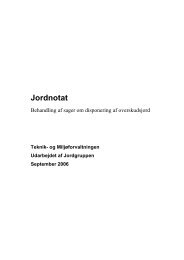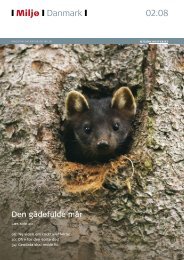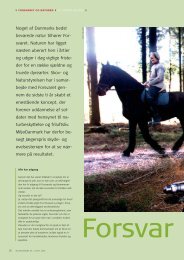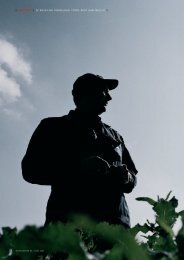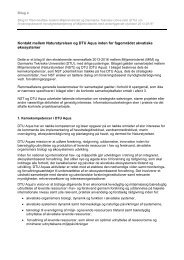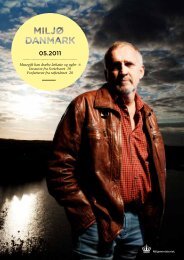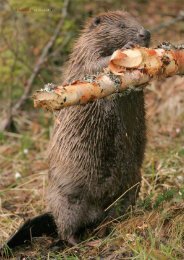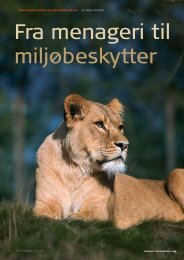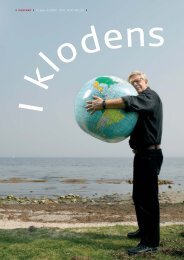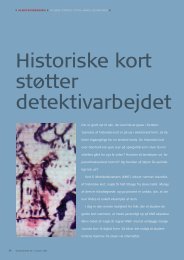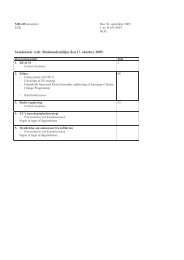You also want an ePaper? Increase the reach of your titles
YUMPU automatically turns print PDFs into web optimized ePapers that Google loves.
FOTO: SCANPIX/CORBIS/DENIS SCOTT<br />
❙ TRUEDE DYR ❙ AF ANNE TORTZEN ❙<br />
<strong>Så</strong> <strong>farlig</strong> <strong>er</strong> <strong>den</strong> <strong>hvide</strong> <strong>haj</strong><br />
Er <strong>den</strong> <strong>hvide</strong> <strong>haj</strong> så <strong>farlig</strong>, som rygtet sig<strong>er</strong>?<br />
– Ja, de <strong>hvide</strong> <strong>haj</strong><strong>er</strong> <strong>er</strong> bygget som rene dræb<strong>er</strong>maskin<strong>er</strong>. Og det <strong>er</strong> koldblodige og udspekul<strong>er</strong>ede<br />
dyr – bare ikke ov<strong>er</strong> for os mennesk<strong>er</strong>, svar<strong>er</strong> biolog Anja Pet<strong>er</strong>sen, <strong>haj</strong>eksp<strong>er</strong>t fra Kattegatcentret.<br />
Hun forklar<strong>er</strong>, at <strong>haj</strong><strong>er</strong> sandsynligvis kun angrib<strong>er</strong> mennesk<strong>er</strong> ved en fejltagelse. D<strong>er</strong>es foretrukne<br />
bytte <strong>er</strong> nemlig sæl<strong>er</strong>, som har nogenlunde samme størrelse og vægt som mennesk<strong>er</strong>.<br />
En an<strong>den</strong> teori <strong>er</strong>, at <strong>haj</strong>en kan finde på at angribe mennesk<strong>er</strong>, d<strong>er</strong> tru<strong>er</strong> <strong>den</strong>s t<strong>er</strong>ritorium. De<br />
<strong>er</strong> nemlig t<strong>er</strong>ritoriale og færdes for det meste alene – også ov<strong>er</strong> lange afstande.<br />
Den store <strong>hvide</strong> <strong>haj</strong> kan blive ov<strong>er</strong> 6 met<strong>er</strong> lang og har tænd<strong>er</strong>, d<strong>er</strong> <strong>er</strong> skarpe som barb<strong>er</strong>blade.<br />
Den angrib<strong>er</strong> altid sit bytte nedefra, og defor <strong>er</strong> <strong>den</strong> “usynlig” på grund af sin mørke<br />
ov<strong>er</strong>side. Hvid<strong>haj</strong>en kan skyde hele und<strong>er</strong>kæben frem og tage en or<strong>den</strong>tlig luns af sit bytte,<br />
som går i chok, hvoreft<strong>er</strong> <strong>haj</strong>en nemt kan vende tilbage og fortære resten.<br />
Helt u<strong>den</strong> hold i virkelighe<strong>den</strong> <strong>er</strong> <strong>haj</strong>ens image som “menneskeæd<strong>er</strong>” dog ikke. Man anslår,<br />
at <strong>den</strong> <strong>hvide</strong> <strong>haj</strong> angrib<strong>er</strong> 5-10 mennesk<strong>er</strong> om året på v<strong>er</strong><strong>den</strong>splan. Til gengæld må op mod<br />
50 af de store <strong>hvide</strong> rovfisk hv<strong>er</strong>t år lade livet, når badestran<strong>den</strong>e ved Sydafrikas, Australiens<br />
og New Zealands kyst<strong>er</strong> skal holdes frie for “dræb<strong>er</strong><strong>haj</strong>en”. Den <strong>hvide</strong> <strong>haj</strong> <strong>er</strong> i fare for at<br />
bukke und<strong>er</strong> for sit ry – h<strong>er</strong> næsten 30 år eft<strong>er</strong> Jaws.<br />
36 MILJØDANMARK NR. 1 FEBRUAR 2005
Jaws<br />
sat und<strong>er</strong> beskyttelse<br />
Kan du huske Jaws, <strong>den</strong> menneskeæ<strong>den</strong>de<br />
dræb<strong>er</strong><strong>haj</strong> med det kæmpemæssige sylespidse<br />
gab, som t<strong>er</strong>roris<strong>er</strong>ede sagesløse ba<strong>den</strong>de i<br />
filmen af samme navn? Den store <strong>hvide</strong><br />
<strong>haj</strong> har – godt hjulpet af publikums<br />
successen fra 1975 – fået ry for at<br />
være en <strong>farlig</strong> menneskeæd<strong>er</strong>. Men i<br />
realiteten <strong>er</strong> det mennesket, d<strong>er</strong><br />
tru<strong>er</strong> <strong>haj</strong><strong>er</strong>ne og ikke omvendt.<br />
MILJØDANMARK NR. 1 FEBRUAR 2005<br />
37
❙ TRUEDE DYR ❙ AF ANNE TORTZEN ❙<br />
Kattegatcentret<br />
Kattegatcentret i Grenaa har et kæmpe<br />
bassin på 550.000 lit<strong>er</strong> tropisk havvand<br />
med mange forskellige slags <strong>haj</strong><strong>er</strong>. De<br />
største <strong>er</strong> 2,5 met<strong>er</strong> lange sandtig<strong>er</strong><strong>haj</strong><strong>er</strong>.<br />
De del<strong>er</strong> bassinet med revle<strong>haj</strong><strong>er</strong>, nurse<strong>haj</strong><strong>er</strong>,<br />
en skæg<strong>haj</strong>, sorttippede og hvidtippet<br />
rev<strong>haj</strong><strong>er</strong>, citron<strong>haj</strong><strong>er</strong> og de elegante pilrokk<strong>er</strong>.<br />
Gå igennem <strong>haj</strong>tunnelen og se nedefra,<br />
hvor stor forskel d<strong>er</strong> kan være på <strong>haj</strong><strong>er</strong>!<br />
Se m<strong>er</strong>e på www.kattegatcentret.dk.<br />
Faktisk <strong>er</strong> <strong>den</strong> store <strong>hvide</strong> <strong>haj</strong> truet i en<br />
grad, så <strong>den</strong> nu har fået plads på CITES<br />
liste ov<strong>er</strong> truede dyr, som d<strong>er</strong> skal holdes<br />
særligt øje med i forbindelse med int<strong>er</strong>national<br />
handel. H<strong>er</strong> <strong>er</strong> det bl.a. <strong>haj</strong>tænd<strong>er</strong>ne,<br />
d<strong>er</strong> <strong>er</strong> populære.<br />
Man regn<strong>er</strong> med, at mennesk<strong>er</strong> tag<strong>er</strong><br />
livet af nogle hundrede <strong>hvide</strong> <strong>haj</strong><strong>er</strong> hv<strong>er</strong>t<br />
år – og det <strong>er</strong> nok til at true <strong>haj</strong>en. Bestan<strong>den</strong><br />
af <strong>den</strong> <strong>hvide</strong> <strong>haj</strong> <strong>er</strong> nemlig sårbar,<br />
fordi <strong>haj</strong><strong>er</strong>ne <strong>er</strong> spredt ov<strong>er</strong> et stort<br />
område og først begynd<strong>er</strong> at yngle, når<br />
de <strong>er</strong> 12-15 år gamle. D<strong>er</strong>for har lan<strong>den</strong>e<br />
i <strong>den</strong> int<strong>er</strong>nationale konvention, CITES,<br />
som kontroll<strong>er</strong><strong>er</strong> handelen med vilde dyr<br />
og plant<strong>er</strong>, besluttet at optage <strong>den</strong> <strong>hvide</strong><br />
<strong>haj</strong> på liste II ov<strong>er</strong> truede dyr. Hajen skal<br />
beskyttes ved at begrænse og kontroll<strong>er</strong>e<br />
<strong>den</strong> int<strong>er</strong>nationale handel med produkt<strong>er</strong><br />
fremstillet af <strong>den</strong>s tænd<strong>er</strong>, finn<strong>er</strong> m.v.<br />
38 MILJØDANMARK NR. 1 FEBRUAR 2005<br />
Niels Nielsen, som <strong>er</strong> biolog i Skov- og<br />
Naturstyrelsen, forklar<strong>er</strong>:<br />
– Det betyd<strong>er</strong>, at handelen med produkt<strong>er</strong><br />
fra <strong>den</strong> <strong>hvide</strong> <strong>haj</strong> skal være bæredygtig.<br />
<strong>Så</strong> hvis du tag<strong>er</strong> til Sydafrika som<br />
turist, og køb<strong>er</strong> et halssmykke med <strong>haj</strong>tænd<strong>er</strong><br />
fra <strong>den</strong> <strong>hvide</strong> <strong>haj</strong>, skal du have<br />
tilladelse fra de sydafrikanske myndighed<strong>er</strong><br />
til at udføre smykket. Og før de<br />
kan give dig <strong>den</strong>, skal de sikre sig, at d<strong>er</strong><br />
<strong>er</strong> tale om en bæredygtig udnyttelse af<br />
<strong>haj</strong><strong>er</strong>ne.<br />
Værdifulde <strong>haj</strong>tænd<strong>er</strong><br />
Den <strong>hvide</strong> <strong>haj</strong>, som bl.a. findes ved Australien,<br />
Californien og Sydafrika, svøm-<br />
m<strong>er</strong> rundt med mange tusinde kron<strong>er</strong> i<br />
gabet. Det <strong>er</strong> <strong>den</strong> primære grund til, at<br />
bestan<strong>den</strong> nu <strong>er</strong> truet.<br />
Måske har filmen Jaws endda været<br />
med til at henlede trofæjæg<strong>er</strong>nes opmærksomhed<br />
på <strong>den</strong> store rovfisk. For i<br />
dag <strong>er</strong> hele tandsæt og enkelt tænd<strong>er</strong> fra<br />
<strong>den</strong> <strong>hvide</strong> <strong>haj</strong> værdifulde trofæ<strong>er</strong>, som<br />
kan indbringe tusindvis af kron<strong>er</strong> i int<strong>er</strong>national<br />
handel. Ifølge CITES <strong>er</strong> hele<br />
tandsæt fra store eksemplar<strong>er</strong> af <strong>den</strong><br />
<strong>hvide</strong> <strong>haj</strong> solgt på det int<strong>er</strong>nationale<br />
marked for fl<strong>er</strong>e hundrede tusinde kron<strong>er</strong>.<br />
Og int<strong>er</strong>nettet har gjort det nemm<strong>er</strong>e at<br />
handle int<strong>er</strong>nationalt med <strong>haj</strong>-trofæ<strong>er</strong>.<br />
FOTO: KATTEGATCENTRET
FOTOS: KATTEGATCENTRET<br />
Haj<strong>er</strong> i Danmark<br />
I havene omkring Danmark kan man støde på op til 18 forskellige<br />
art<strong>er</strong> af <strong>haj</strong>. Det <strong>er</strong> dog kun de seks, d<strong>er</strong> færdes h<strong>er</strong> hele året rundt.<br />
Den mest almindelige <strong>haj</strong> i de danske farvande <strong>er</strong> <strong>den</strong> storplettede<br />
rød<strong>haj</strong>. Den største <strong>er</strong> brug<strong>den</strong>, som med sine op til 10 met<strong>er</strong> hør<strong>er</strong><br />
til blandt v<strong>er</strong><strong>den</strong>s all<strong>er</strong>største <strong>haj</strong><strong>er</strong>. Den <strong>er</strong> dog en fredelig plankton-æd<strong>er</strong>.<br />
Det nærmeste, vi komm<strong>er</strong> <strong>farlig</strong>e <strong>haj</strong><strong>er</strong>, <strong>er</strong> måske blå<strong>haj</strong>en,<br />
som kan trække ind i Nordsøen. Den findes kun langt til havs.<br />
De mange penge, som gemm<strong>er</strong> sig i gabet<br />
på <strong>den</strong> <strong>hvide</strong> <strong>haj</strong>, gør <strong>den</strong> til et yndet<br />
bytte både for sportsfisk<strong>er</strong>e og komm<strong>er</strong>cielle<br />
fisk<strong>er</strong>e. Ifølge CITES <strong>er</strong> d<strong>er</strong> sportsfisk<strong>er</strong>e,<br />
som betal<strong>er</strong> i dyre domme for at<br />
komme på nært hold af de <strong>hvide</strong> <strong>haj</strong><strong>er</strong> og<br />
tage kampen op – mand mod <strong>haj</strong>. De dyst<strong>er</strong><br />
om at nedlægge det største og flotteste<br />
eksemplar, for at få de største kæb<strong>er</strong><br />
og tænd<strong>er</strong> som trofæ.<br />
En spektakulær fangst<br />
– Den store, <strong>hvide</strong> <strong>haj</strong> <strong>er</strong> et sejt bytte,<br />
fordi <strong>den</strong> kæmp<strong>er</strong> længe og spektakulært.<br />
Ligesom sværdfisk, d<strong>er</strong> også <strong>er</strong> prestige i<br />
at nedlægge, fortæll<strong>er</strong> biolog Anja Pet<strong>er</strong>sen.<br />
Hun <strong>er</strong> eksp<strong>er</strong>t i <strong>haj</strong><strong>er</strong> og ansat som<br />
akvarist ved Kattegatcent<strong>er</strong>et – hun pass<strong>er</strong><br />
til daglig de mindre eksemplar<strong>er</strong> af<br />
arten, som går i cent<strong>er</strong>ets akvari<strong>er</strong>.<br />
Småplettet Rød<strong>haj</strong>, øv<strong>er</strong>st,<br />
findes i danske farvande<br />
og kan blive 70 cm lang.<br />
Citron<strong>haj</strong>en, ned<strong>er</strong>st, <strong>er</strong><br />
en almindelig <strong>haj</strong>art i havet<br />
langs Mexicos og Floridas<br />
kyst<strong>er</strong>, Den kan blive op til<br />
3 met<strong>er</strong> lang.<br />
Den <strong>hvide</strong> <strong>haj</strong> lev<strong>er</strong> bl.a. af sæl<strong>er</strong> og<br />
hold<strong>er</strong> d<strong>er</strong>for ofte til forholdsvis tæt på<br />
kysten, hvor d<strong>er</strong> <strong>er</strong> føde at finde. Det<br />
kombin<strong>er</strong>et med en modig og nysg<strong>er</strong>rig<br />
natur gør <strong>den</strong> også til et forholdsvis nemt<br />
bytte for de komm<strong>er</strong>cielle fisk<strong>er</strong>e. Nogle<br />
går direkte eft<strong>er</strong> <strong>den</strong> <strong>hvide</strong> <strong>haj</strong>, men det<br />
sk<strong>er</strong> ikke sjæl<strong>den</strong>t, at <strong>haj</strong><strong>er</strong> ved et uheld<br />
komm<strong>er</strong> i nettet. Og så <strong>er</strong> det oplagt for<br />
fisk<strong>er</strong>e, d<strong>er</strong> egentlig <strong>er</strong> ude i andet ærinde,<br />
at dræbe <strong>haj</strong>en og score gevinsten på<br />
land. Hajkødet <strong>er</strong> hell<strong>er</strong> ikke at foragte.<br />
Især finn<strong>er</strong>ne betragtes i mange asiatiske<br />
lande som en delikatesse.<br />
Handel med<br />
truede dyr<br />
und<strong>er</strong> kontrol<br />
Handel med vilde dyr og plant<strong>er</strong> <strong>er</strong> en meget<br />
indbringende forretning, og omsætningen<br />
skønnes at ligge på mindst 40 milliard<strong>er</strong> kron<strong>er</strong><br />
årligt. CITES, også kaldet Washingtonkonventionen,<br />
<strong>er</strong> en int<strong>er</strong>national konvention,<br />
d<strong>er</strong> kontroll<strong>er</strong><strong>er</strong> og regul<strong>er</strong><strong>er</strong> handlen med<br />
vilde dyr og plant<strong>er</strong>. Målet <strong>er</strong>, at kun bæredygtig<br />
handel skal være tilladt – dvs. at man<br />
fj<strong>er</strong>n<strong>er</strong> ikke m<strong>er</strong>e fra bestan<strong>den</strong>e af dyr og<br />
plant<strong>er</strong>, end de kan bære.<br />
I alt ca. 30.000 art<strong>er</strong> af dyr og plant<strong>er</strong> <strong>er</strong><br />
omfattet af konventionen. Godt 1.000 af dem<br />
<strong>er</strong> så stærkt truede, at handel med dem <strong>er</strong><br />
totalt forbudt. For de øvrige kræves tilladelse<br />
til ind- og udførsel.<br />
Alle CITES 166 medlemslande kan foreslå at<br />
optage en truet art på en af list<strong>er</strong>ne. Det<br />
kræv<strong>er</strong> et stort forarbejde at dokument<strong>er</strong>e,<br />
hvor arten lev<strong>er</strong>, og hvordan <strong>den</strong> <strong>er</strong> truet.<br />
Forslagene diskut<strong>er</strong>es af medlemslan<strong>den</strong>e på<br />
en partskonf<strong>er</strong>ence, som holdes hv<strong>er</strong>t tredje<br />
år. Det kræv<strong>er</strong> 2/3 fl<strong>er</strong>tal, at få en art optaget<br />
på en af de tre list<strong>er</strong>.<br />
Konventionen fastsætt<strong>er</strong> forskellige<br />
grad<strong>er</strong> af beskyttelse<br />
af disse plant<strong>er</strong> og dyr afhængigt<br />
af, hvor truede man skønn<strong>er</strong>,<br />
at de <strong>er</strong>.<br />
– Liste I rumm<strong>er</strong> de art<strong>er</strong>, som <strong>er</strong> stærkt udryddelsestruede.<br />
Dem <strong>er</strong> det forbudt at<br />
handle med. Det gæld<strong>er</strong> fx tig<strong>er</strong>, panda og<br />
næsehorn.<br />
– Liste II indehold<strong>er</strong> art<strong>er</strong>, som ikke umiddelbart<br />
<strong>er</strong> truet af udryddelse, men som kan<br />
blive det, hvis ikke handelen kontroll<strong>er</strong>es<br />
nøje. For at kunne ind- ell<strong>er</strong> udføre disse art<strong>er</strong><br />
kræves særlige import- ell<strong>er</strong> eksporttilladels<strong>er</strong>.<br />
– Liste III omfatt<strong>er</strong> art<strong>er</strong>, som lokalt <strong>er</strong> truede<br />
af handel. Handel <strong>er</strong> tilladt, hvis <strong>den</strong> foregår<br />
på en kontroll<strong>er</strong>et måde.<br />
Det <strong>er</strong> de lande, hvor <strong>den</strong> truede dyre- ell<strong>er</strong><br />
planteart hør<strong>er</strong> hjemme, d<strong>er</strong> skal godkende al<br />
handel. Og alle medlemslande skal hv<strong>er</strong>t år<br />
rapport<strong>er</strong>e til CITES ov<strong>er</strong> ind- og udførsl<strong>er</strong> af<br />
dyr og plant<strong>er</strong>. Ligesom de skal holde øje<br />
med bestan<strong>den</strong> af de truede<br />
dyr.<br />
MILJØDANMARK NR. 1 FEBRUAR 2005<br />
39





